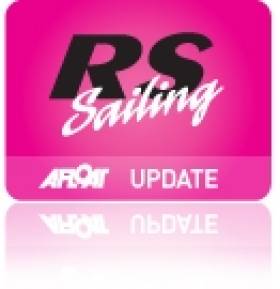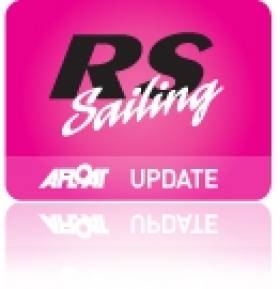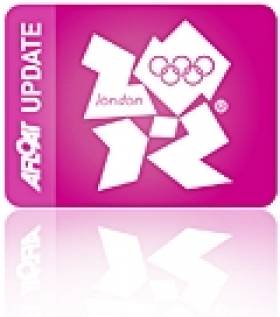Displaying items by tag: RS Sailing
Success for Royal St George Teams at Irish RS Nationals
#RS SAILING - Howth Yacht Club hosted 54 boats in three classes for the RS400, RS200 and RS Feva National Championships over the weekend (click HERE for photos).
The Irish version of the 'RS Games' proved a big hit with all competitors. The race management team, headed by PRO David Lovegrove, did a fantastic job to get 10 races in for all three classes in spite of some shifty conditions.
This was all the more impressive as each course change required the moving of up to 10 marks. No mean feat, but the Howth Yacht Club team took it in their stride.
In the RS400 class, bothers Emmet and James Ryan from the Royal St George Yacht Club took the top spot. They didn’t make things easy by using up a discard on the first race of the event and only snatched the win on the last run of the last race having rounded the final weather mark in fourth place.
Greystones class stalwarts Simon Herriott and Tom Moran took second place, while in third place, and the top youth RS400 team, was a very impressive display by Andy Verso and Oisin Baugh, also from Greystones.
In the RS200 class it was another family affair and another Royal St George win with father-and-son pair Sean and Stephen Craig taking first place. It was extremely tight at the top of the 200 fleet with only three points separating the top four boats in the end.
Teams from Greystones filled the next two podium places with Frank and Kevin O’Rourke taking second and last year’s champions Roy Van Maanen and Glen Reid taking third place.
In the Feva class, GB sailors filled the top three slots with Elliott Wells and Jake Todd taking the title on count back from fellow Hayling Island sailors Tom Darling and Will Dolin. Chay and Stirling Taylor took third place.
In the battle for local/Irish bragging rights, Eoin Lyden and Brian Stokes from Cork got one over the Dublin rivals to claim top Irish Feva spot.
Full results can be found at the Howth Yacht Club website at www.hyc.ie, while photos of the event are available HERE.
Gales Can't Stop Inaugural Dun Laoghaire Dinghy Event
An impressive turnout of 30 RS400's and RS200's braved extremely testing conditions inside Dun Laoghoire Harbour for the running of the first edition of the RS Sprint Trophy. The crews, who made the trip from as far a field as Cushendall Co. Antrim, were rewarded with 8 fantastic races. On the tight short courses the emphasis for the day was definitely on boat handling. Any minor mistakes made by the crews were immediately punished.
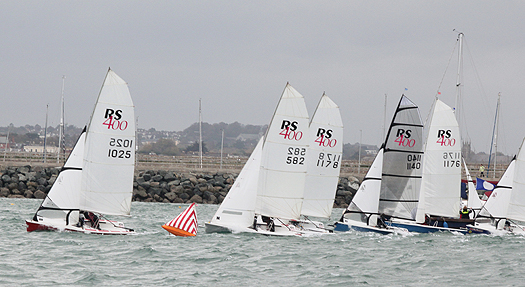
An RS400 start in yesterday's Dun Laoghaire RS sailing event. Photo: Bob Hobby
With the east pier weather station clocking gusts of over 32 knots, the race management team of Barry O'Neil, Jim Dowling, and Bob Hobby along with an excellent backup team both on and off the water played a blinder. They somehow managed to squeeze a challenging parallelogram course inside the tight confines of the harbour walls. The competitors were grateful for every inch of space. The harbour seemed a very small place once the boats were blasting at full plane under spinnaker!
With a larger than expected entry, both classes were split into two flights. The scores from each flight were calculated after five races, then the classes were separated into Gold/Silver fleets. A further three races followed. With no discards for the series and the final race counting for double points, there was still all to play for going into race 8.
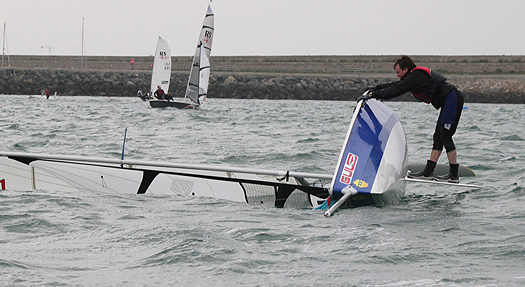
In the RS200 fleet, national champions Roy Van Maanen and Glen Reid won the day. All of their experience and superior boat handling counted to a very consistently high performance. Second place in the 200 fleet went to the husband and wife team of Sean and Heather Craig. This was an impressive result as it was their first dinghy event together this season. Third spot in the class went to Greystones junior Enzo Michel in his new boat. Seeing how well Enzo preformed on the day is sure give those juniors planning to make the move up from the RS Feva plenty of encouragement.
In the RS400 class it was again the national champion, Simon Herriott who prevailed. Simon showed blistering pace downwind and nailed every gybe flawlessly with his new crew Shane McCarthy. Second in the 400's went to the Royal North pairing of Liam Donnelly and Andrew Vaughan, this despite breaking their spinnaker pole in the penultimate race. In third place and also from the Royal North were Simon Hutchinson and Rosemary Moore who put in a great performance.
The winners from each class were rewarded with two fittingly impressive perpetual trophies, which were very kindly sponsored by www.noonanboats.com
The consensus amongst everyone who took part was that this event would be a definite on next years RS calendar. The Sprint Trophy proved to be a uniquely exciting format that rounds off a hugely successful season for the growing RS Classes.
In addition to the racing a number of trial sails were run by Pete Vincent of www.2ndhanddinghies.com and his expert crew Charlotte Cotter who made the trip from Southampton for the event. The feedback given by those who had a trail sail was emphatically positive. Pete also gave a presentation after racing to prospective RS200 junior sailors and parents. Those who took the opportunity to see the boats first hand commented that they could see why the two classes are so popular in the UK, with the RS200 attracting 157 boats to the UK Nationals and RS400 boasting an entry of 86 boats. Both classes are sure to see growing numbers for next season. Some new faces in the both the RS200 & RS400 have already signed up to enter this years DMYC Frostbite series.
RS900 Put Forward as Women's Olympic Skiff Contender
Following ISAF's final choice of sailing events for the 2016 Olympics, including a women's skiff, RS Sailing has announced it plans to develop the RS900 to compete for this role.
While that selection decision is yet to be made by an evaluation team across a range of designs a more immediate issue for Ireland is trying to find an Irish women's crew to campaign such a boat for Brazil.
There is huge interest in the new skiff style sailing internationally but Ireland have not had a double handed women's dinghy crew since Atlanta 1996 so gauging interest here in the new class might be difficult.
The RS900 will be an all-new boat incorporating developments from the highly respected RS800 hull, a new deck, new wings and a new rig. The RS900 will only go into full production if it is selected for the Olympics.
Early testing of a prototype RS900 has shown the performance can be close to a 49er - with optimised handling targeted to suit ISAF's specified weight range for female teams.
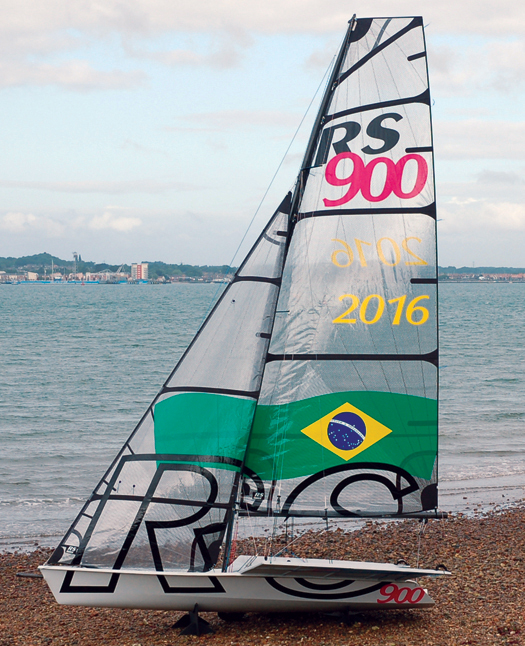
The new RS900 - a new Olympic class?
RS Sailing is also one of the very few companies with proven credentials for the production of one-design race boats in large volumes, plus an established global distribution network – able, therefore, to be a strong partner for ISAF in the successful introduction of a new flagship Olympic event.
"This is a serious project for us" says Martin Wadhams, managing director of RS Sailing. "It will take a great boat to do justice to the Olympic role and a new generation of female sailing athletes. It will also take a significant commitment to work with ISAF on the strategy to launch the new class quickly and effectively if it wins selection. We're up for that."
Nick Peters, head of development at RS Sailing comments "We learned at lot from the initial women's skiff trials at Hyeres four years ago. The RS800 which we took there was perhaps the closest existing class to meet the requirement range of a new Olympic boat – but we understood that the final boat we put forward would need to be more responsive, faster and more challenging to sail. Early sailing of the new RS900 leaves us in no doubt that we have a worthy skiff on our hands. We just need final confirmation of some key evaluation criteria, such as the target sailor weight range, to allow us to confirm we'll undertake the investment needed to compete and then refine the boat to the role."
A number of key features can be seen from the photos, but are liable to change. More technical details will be released as development progresses and all elements are finalised.


























